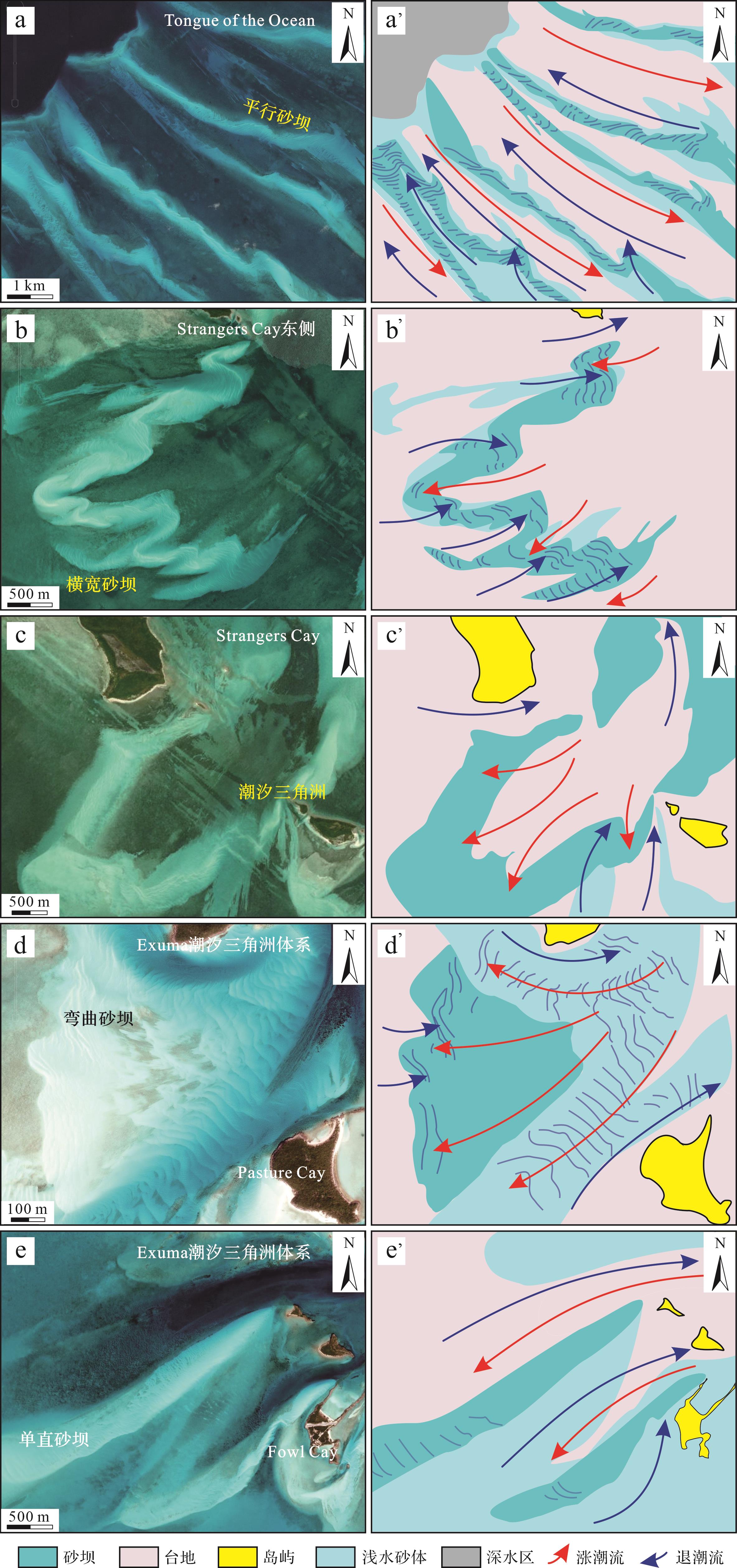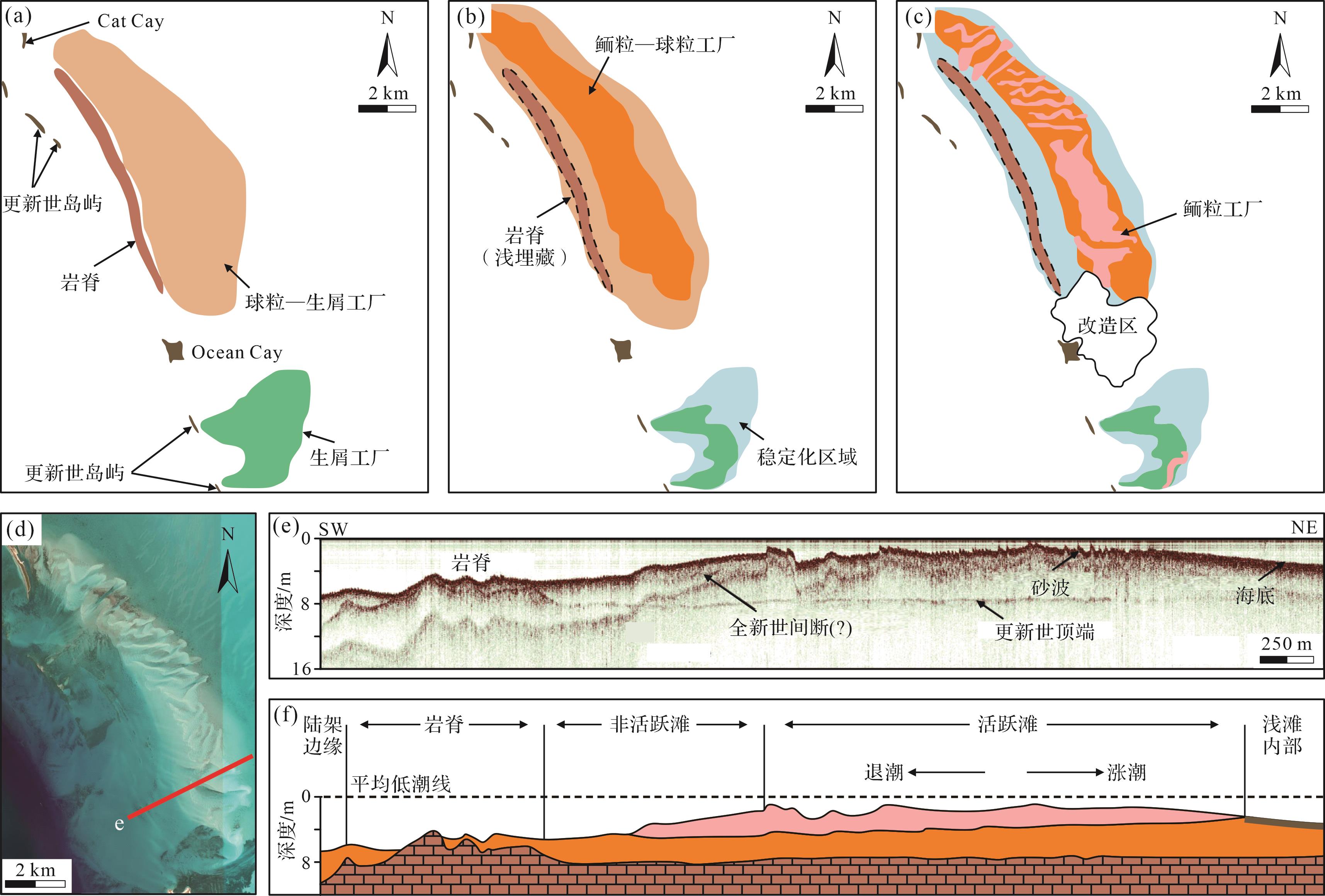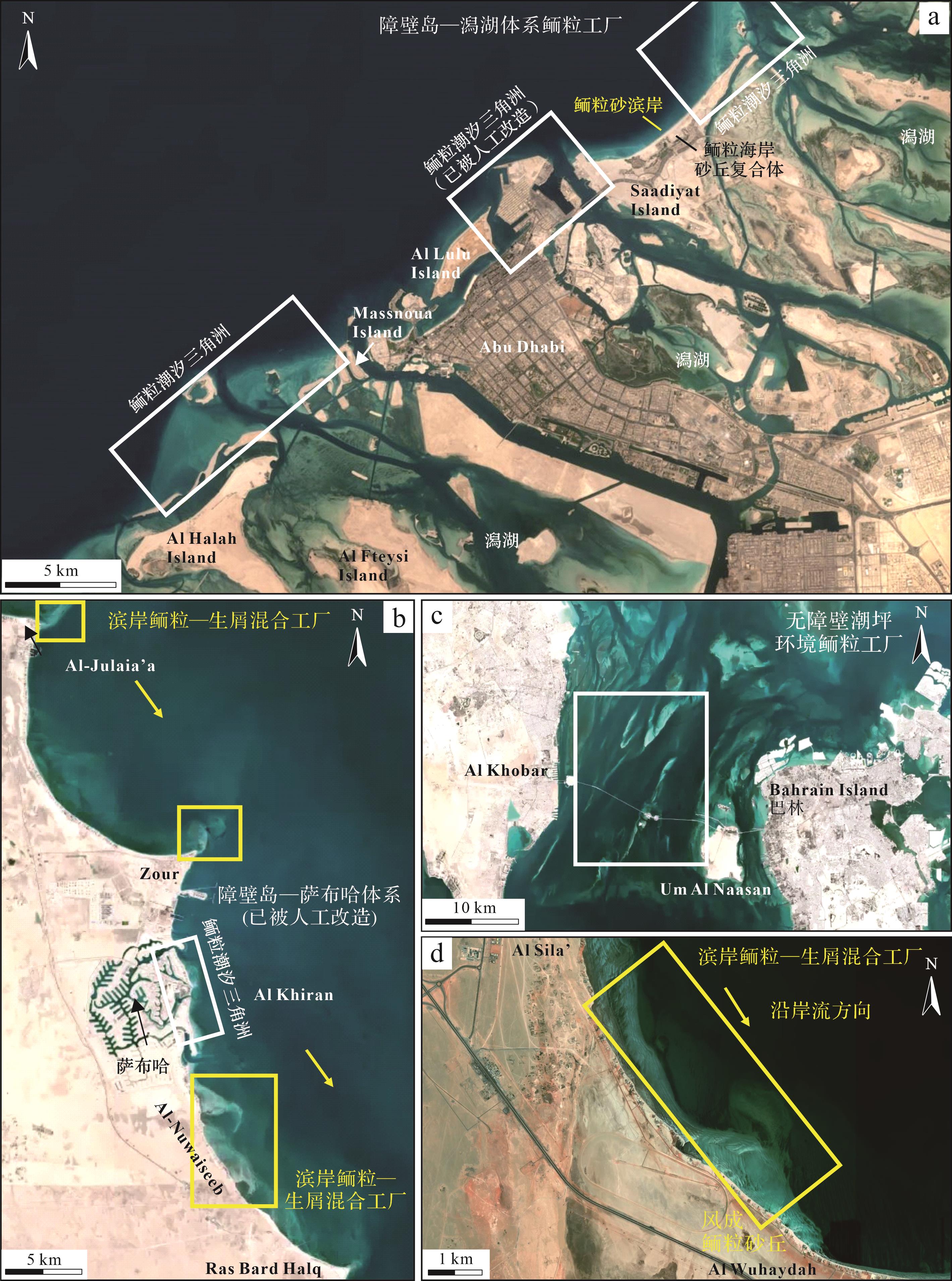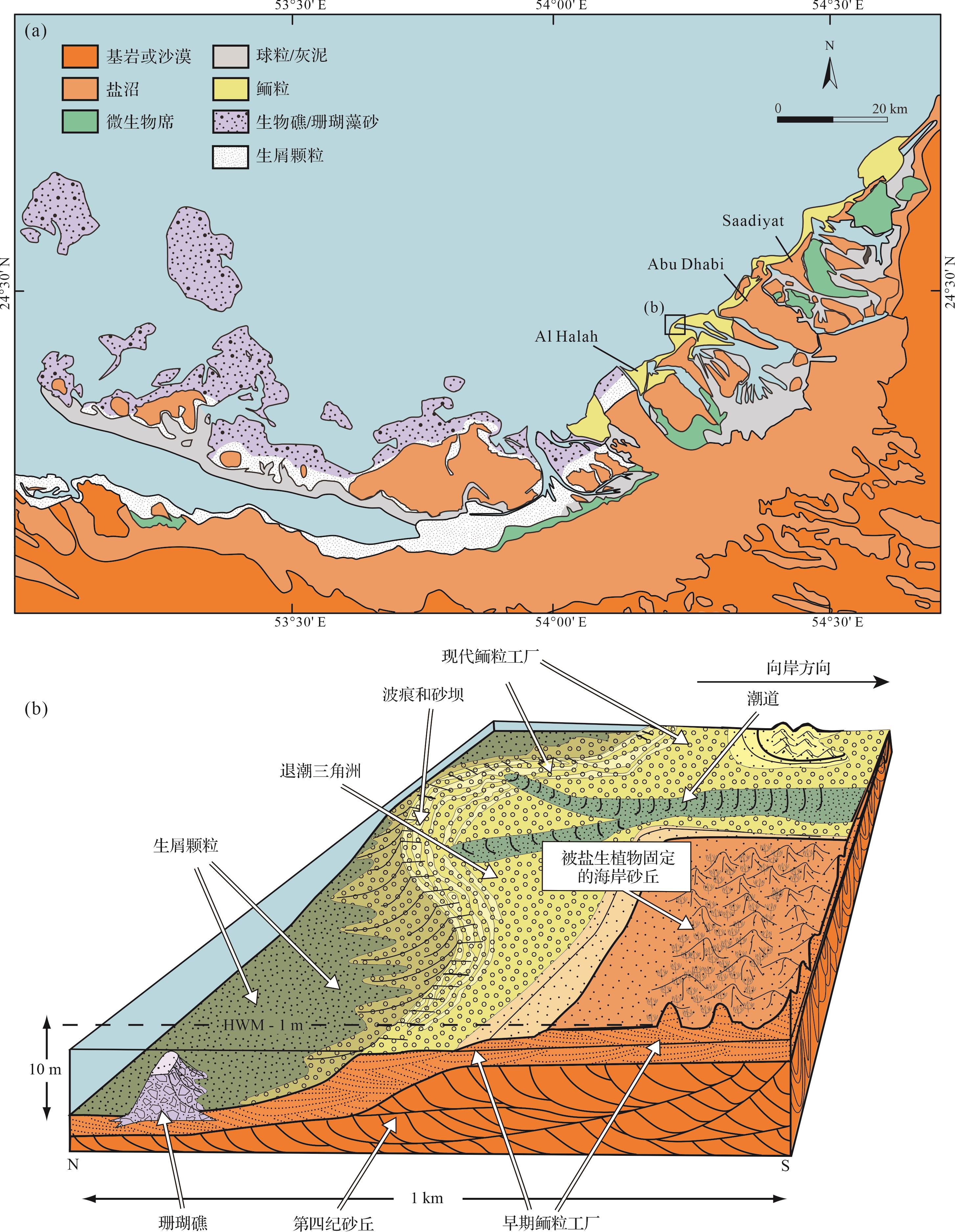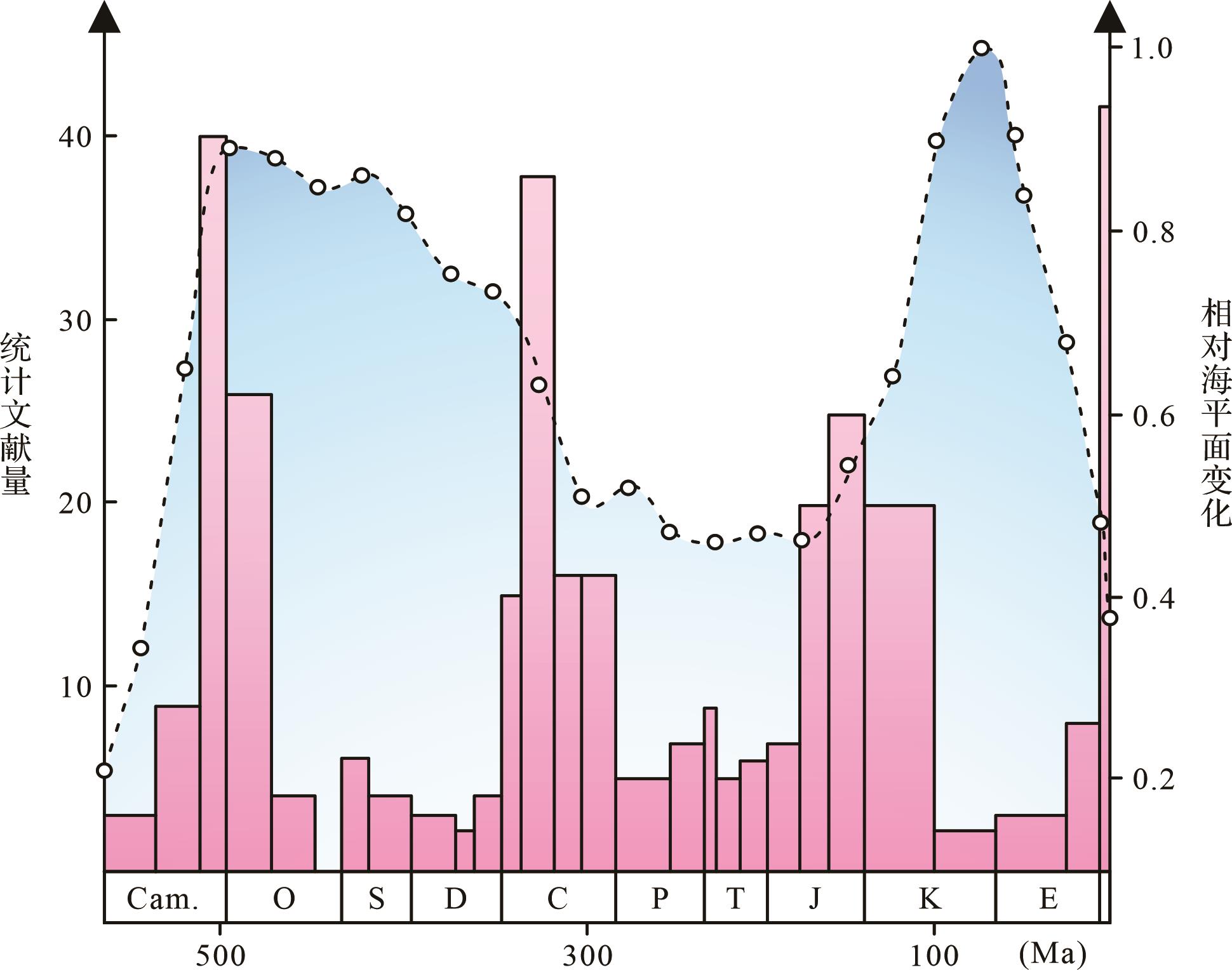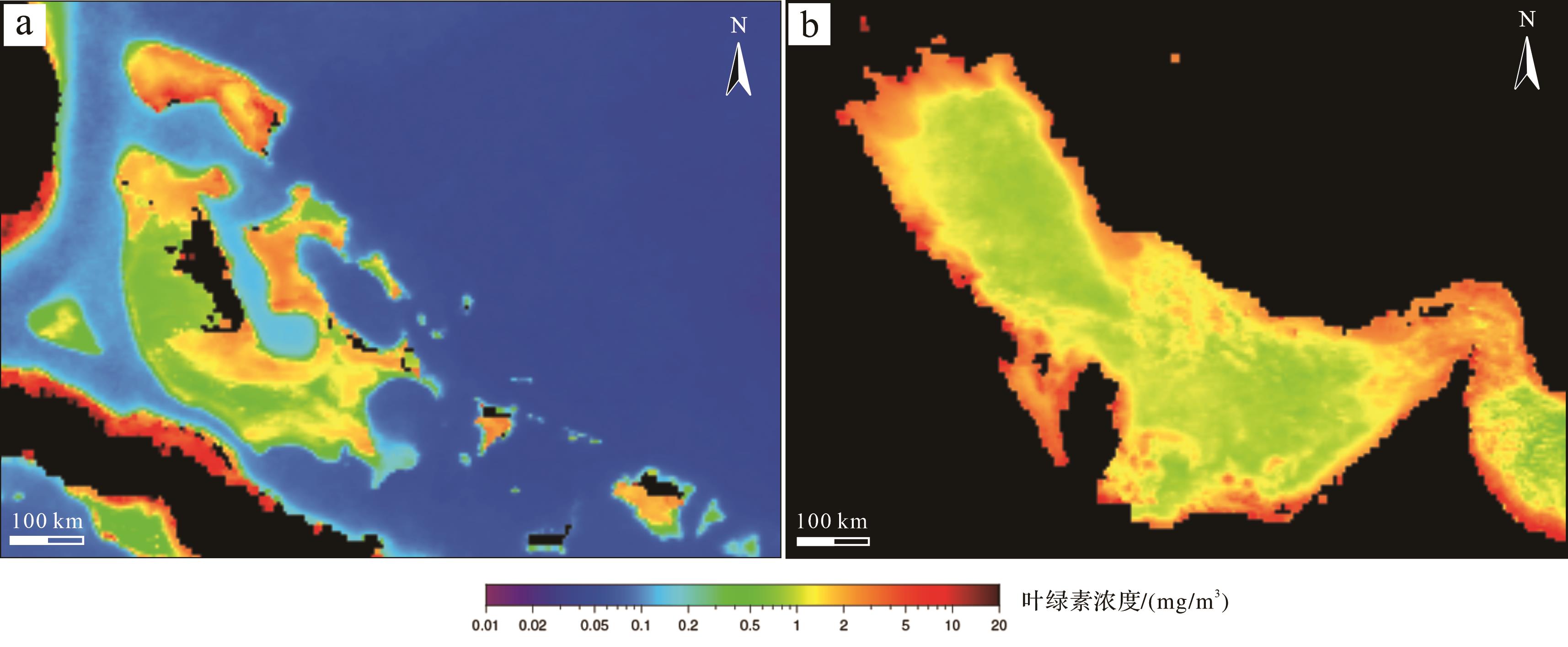HTML
-
鲕粒是一种球形或椭球形的颗粒,由核心和一系列光滑均匀的纹层构成[1]。它的粒径通常介于0.25~2 mm,主要由钙质、铁质和磷质等成分组成[2]。鲕粒在海洋环境下以钙质成分为主(本文关注重点,下同),是一种典型的非骨骼碳酸盐颗粒,在地质历史和现代环境中广泛发育[3⁃4]。鲕粒的成因目前仍有争议,除了传统的化学沉淀模式,近年来以有机矿化作用为主的生物化学模式也逐渐得到认可[5⁃6]。鲕粒主要形成于水体能量较强的潮坪和滨岸环境,水深一般不超过5 m[7⁃9]。前人研究表明,现代鲕粒形成于温暖、碳酸盐矿物过饱和(Ω文石>3.8)、盐度略高于正常海水的环境[4,10]。鲕粒的原生矿物类型一般为文石、低镁方解石和高镁方解石[3,11⁃12]。鲕粒的发育与海水化学性质密切相关,即使内部存在有机矿化过程,也是在最初的无定形碳酸钙形成阶段[13]或者是在生物诱导作用下的海水环境中沉淀结晶[14]。因此,鲕粒所保存的矿物类型,以及稀土元素和金属稳定同位素的组成,常被用作指示海水化学成分和环境条件变化的替代指标[15⁃20]。
鲕粒滩是一种现代海洋环境下的碳酸盐沉积体,主要分布在南、北回归线附近地区,如大西洋的加勒比海[21]、西亚的波斯湾[22]、澳大利亚的北部海岸[23]和南太平洋的一些岛屿[24⁃25]。鲕粒滩的面积可达数千平方千米,其中最大的一个是巴哈马的TOTO(Tongue of the Ocean,3 120 km2)(图1a)[26]。在地质历史时期,鲕粒岩的分布和发育更为广泛。在一些特定时期,如早三叠世,鲕粒岩是热带浅水碳酸盐建造的主要类型之一[27⁃28]。考虑到大规模鲕粒产出所引发的沉积、环境和资源效应,称之为鲕粒工厂是恰当的。
碳酸盐工厂的概念和内涵近年来不断演化,从最早指代碳酸盐沉积物的汇聚场所[29⁃30],到后来引入底栖生产者类型、内在属性和环境适应性等要素[31⁃34],再到进一步考虑生产过程、沉积体形态演化、生态可容空间、生产规模和效率之间的相互关系等方面内容[35⁃37]。与传统的碳酸盐沉积学相比,碳酸盐工厂研究更重视生产者、生产过程,以及与环境的相互关系[35]。对碳酸盐工厂分类和属性方面的研究被认为是“近三十年来碳酸盐沉积学领域的一项重要进展”[34];相关理论被国外新版沉积学教材广泛采用,前景广阔[38⁃40]。
按照Schlager[31]提出的经典工厂分类方案,大规模发育的鲕粒既不属于以自养型生物控制作用为主的热带浅水工厂,也不属于以生物诱导作用为主的灰泥丘工厂(或“M工厂”,以微生物和灰泥沉积为主[33])。因此,不同学者有不同的分类建议,有的认为鲕粒应单独进行分类[27],有的认为鲕粒应划入新的生物化学工厂[41],还有的认为鲕粒应归于“特异性T工厂”的亚类(T.热带的和水柱顶部[33];生物化学T工厂)[42]。无论如何划分,不同类型的碳酸盐沉积体系都应该有其自身独特的生产规律。鉴于此,本文旨在探索以鲕粒为主导的沉积体系(即鲕粒工厂)发育规律,通过研究现代典型的镶边台地型和缓坡型鲕粒工厂(图1)的组成、特征和分布规律,剖析其形成环境、发育条件和主要影响因素,以期揭示鲕粒工厂的生产过程和发育机制,为深入理解碳酸盐工厂在古环境演化、沉积过程和动力学机制,以及储层分布和富集规律方面的意义提供参考。
-
大西洋加勒比地区是现代海洋环境下鲕粒最为发育的地区,它们分布在一系列孤立碳酸盐台地边缘,其中大巴哈马滩(台地)、小巴哈马滩(台地)、Crooked-Acklins台地和Caicos台地是最具代表性的(图1a)。以大、小巴哈马滩为例,分别从工厂的建造者、构成、分布范围、建造过程、与其他工厂类型的关系,以及成岩作用影响等角度进行介绍。
-
鲕粒是工厂最主要的建造者,由砂级大小的(350~600 μm为主)球形、椭球形颗粒构成[44]。鲕粒核心主要为球粒或生物碎片,包壳主要由切线状排列的文石针构成纹层。少量共生的颗粒类型包括球粒,以及有孔虫、仙掌藻、双壳类等生物碎片[44⁃45]。
-
鲕粒工厂分布于台地边缘的高能环境[8,26]。其中完全由鲕粒构成的工厂形成于水体能量最强的浅滩顶部,然后向滩体周缘逐渐过渡为以鲕粒为主、含有生屑和球粒的复合型工厂[46⁃47]。工厂的发育范围和规模受水动力条件和地貌等因素的制约(图2)。水动力条件越强,形成的鲕粒工厂面积越大,滩体建造厚度越大,同时鲕粒粒径也有增大的趋势[46]。由于台地边缘坡度较陡,鲕粒工厂从台缘向海洋方向的发育很快就会终止(图2a)。而向台地方向,工厂中鲕粒粒径总体上会减小,潮汐通道也会变窄;鲕粒滩体形态会从平行海流方向(图2a)向垂直海流方向转变(图2b)[21]。

Figure 2. Satellite images and schematic drawings of ooid⁃sand bar forms and tidal direction on the Bahama Banks
鲕粒工厂的分布还受古地貌因素的影响。当台缘带同时存在生物礁和古地貌高地(如岩脊和岛屿等)时,鲕粒工厂主要发育在台缘带的内侧,包括潮汐通道的两侧(涨潮三角洲和退潮三角洲)、潮道边缘,以及地貌高部位的周缘(图2b,c)。在没有生物礁和古地貌高地且潮流强烈的地区,鲕粒工厂占据了整个台缘带,形成了一系列与海流方向近似平行的辐射状滩体(图2a)。在有古地貌高地但没有生物礁的地区,鲕粒工厂主要沿着受古地貌高地影响的动荡环境发育(如Joulters Cay),并且在海平面上升过程中形成了两种建造样式:(1)外侧由纯鲕粒构成的加积型隆起状样式;(2)内侧由鲕粒、生物碎片和球粒共同构成的混合样式[48⁃49]。同时,持续的鲕粒加积过程还在大、小巴哈马滩的部分地区形成了镶边型台缘带(图1a),降低了台内水体的动荡程度,并限制了完全由鲕粒构成的工厂的发育范围[48⁃49]。
-
鲕粒在海水及海底环境主要存在三种状态:悬浮、海底停留(滚动和跳跃)和埋藏。一般来说,鲕粒在海水中的悬浮时间很短,特别是当粒径大于一定范围(0.4~0.7 mm)后,以海底停留和埋藏状态为主[50]。根据Anderson et al.[51]的模型,鲕粒在单个生长周期内主要经历了三个阶段,包括:(1)鲕粒随砂体迁移至背流面后发生分选,之后随砂体被掩埋;(2)同类型鲕粒在砂体内部碳酸盐过饱和的孔隙水条件下形成早期环带型胶结物;(3)随着滩体迁移,鲕粒再次暴露于海底环境,在迎流面搬运过程中新形成的胶结物不断碰撞、磨蚀,逐渐形成光滑纹层,之后再次被迁移至背流面,准备进入下个生长周期。整个过程周而复始,推动鲕粒不断生长,直到滩体迁移终止。鲕粒滩体形态则主要受水流方向、水动力条件和地貌控制。据Rankey et al.[21,44]的总结,鲕粒滩体形态主要包括五种类型(图2):(1)平行砂坝;(2)横宽砂坝;(3)潮汐三角洲;(4)弯曲砂坝;(5)单直砂坝。
巴哈马台地上的鲕粒工厂形成于全新世以来的海侵过程。鲕粒工厂的发育位置主要有两种:古地貌高地周缘和台地边缘平坦地区[51-54]。围绕古地貌高地发育的鲕粒工厂较为常见,以Joulter Cays最为典型(图1a、图2c~e)。鲕粒工厂的发育过程据Harris[48]归纳可分为三个阶段:(1)冰期结束后,在更新世基岩上形成初始海泛沉积;(2)在继承性地貌高部位率先浅滩化(主要由球粒构成);(3)在地貌高地附近的强水动力环境发育鲕粒滩,范围逐渐扩展至潮间带附近。随着鲕粒滩向台地内部的高能环境(如潮道和砂坝)扩展,其他环境逐渐变得局限并转为球粒、生屑和灰泥沉积。活跃的生物扰动进一步增加了鲕粒与球粒和灰泥的混合程度。另一方面,对于台缘初始平坦地貌上鲕粒工厂的建造,以Cruz et al.[52⁃53]对Ocean Cay北部的研究最为深入(图1a、图3a~d),主要过程包括:(1)冰期结束后,在更新世基岩(岩脊或岛屿)内侧形成初始海泛沉积。南部发育由生屑颗粒构成的涨潮三角洲,北部发育由生屑—球粒构成的浅滩;(2)随着海侵继续,南部的潮汐三角洲逐渐固定,新的生屑滩在其上发育。北部在隆起的地貌上发展出鲕粒—球粒滩体;(3)南部维持原状并出现零星的鲕粒滩体,北部在原有的鲕粒—球粒滩之上进一步形成一系列完全由鲕粒构成的潮道和砂坝。
-
巴哈马台地上常见的特异性工厂类型除了鲕粒工厂之外,还有珊瑚礁工厂[55]、骨屑—球粒工厂[8,56]、微生物碳酸盐工厂[57⁃59]和灰泥工厂[60]等。在台地边缘环境下,鲕粒与生屑和球粒近原地共存,构成鲕粒—生屑—球粒混合工厂(图3)[8];在潮下带的高能潮道环境中,鲕粒与叠层石、凝块石和岩化微生物席共存,构成鲕粒—微生物碳酸盐混合工厂[59,61];在台地内部的相对低能环境中,可以看到少量异地搬运的鲕粒与原地灰泥的组合[62]。此外,鲕粒工厂与珊瑚礁工厂很少混合共存,两者只是空间上呈临近关系[62]。
鲕粒工厂与其他类型工厂的关系可能主要取决于水动力条件和台地底形。在台地边缘环境中,完全由鲕粒构成的工厂主要分布在水体能量最强的区域[63],尤其是滩脊处的颗粒分选性很好[44];滩体两侧和潮道内部的颗粒分选变差,生屑和球粒等其他颗粒类型逐渐增加[44]。另一方面,由于台地边缘的坡度较陡,水体的动荡程度随着深度的增加而明显降低,使得鲕粒工厂难以向广海方向扩展;工厂类型也随水体深度的增加快速变为鲕粒—生屑—球粒混合工厂和灰泥工厂[48,64]。
-
巴哈马台地上的鲕粒工厂主要受海水成岩作用和大气淡水成岩作用的影响。在海水成岩环境中,颗粒的边缘被文石质的胶结物或泥晶组构固定[65]。在大气淡水成岩环境中,部分鲕粒在颗粒的边缘(悬挂形)和颗粒之间(新月形)快速形成粒状的低镁方解石胶结物[66]。这些过程有利于鲕粒工厂的稳定。鲕粒的形成与海水的化学沉淀和有机质的降解有关,后者涉及微生物的新陈代谢活动和有机矿化过程[5⁃6]。然而,淡水溶蚀和早期成岩过程中促进溶解的新陈代谢过程(如有氧氧化作用)会导致鲕粒和早期胶结物的溶解[66]。这些浅埋藏成岩作用对工厂的早期保存影响较大,尤其是对鲕粒工厂的孔隙度和渗透率的早期改造;这些改造可能影响后期流体运移和其他成岩过程[64]。
1.1. 工厂建造者及主要特征
1.2. 工厂构成及分布范围
1.3. 建造过程
1.4. 与其他工厂类型关系
1.5. 成岩作用影响
-
波斯湾是位于阿拉伯半岛和伊朗高原之间的半封闭海湾,属于中东地区。该地区气候干燥,形成了以碎屑组分和碳酸盐组分混合的缓坡为主的沉积体系(图1b)。阿拉伯半岛一侧的浅水沉积区坡度极缓,碳酸盐沉积物占主导;伊朗高原一侧受上新世—更新世构造活动影响坡度较陡,浅水沉积区狭窄,以碎屑沉积物为主[67]。鲕粒工厂主要分布在靠近阿拉伯半岛一侧的浅水沉积区,宽度不超过5 km(图1b)[68⁃70],包括科威特、沙特阿拉伯、卡塔尔、阿拉伯联合酋长国等国家的部分滨海环境(图4)。一些由异地搬运作用形成的鲕粒堆积体分布在深水盆地(水深约100 m)(图1b)和陆上海岸砂丘环境(图4d)[22,67⁃68]。
-
开阔环境下,鲕粒主要由切线状文石针定向排列而成的同心纹层结构构成,纹层间也夹杂少量的暗色、富有机质的纹层[22,69]。局限潟湖环境中,鲕粒则以纤维状文石针形成的放射状纹层结构为主[22]。鲕粒的核心主要是石英和其他陆源碎屑颗粒[22];共生生物碎屑主要是球粒、有孔虫、腹足类和钙藻类[70]。鲕粒的粒径介于0.25~2 mm,水体能量越强,粒径越大(接近2 mm)[22]。
-
鲕粒工厂主要形成于障壁岛—潟湖(含萨布哈)、无障壁潮道和滨岸环境(图4)。其中,障壁岛—潟湖环境下的鲕粒工厂以阿联酋阿布扎比附近Al Halah岛至Saadiyat岛之间的区域最为典型(图4a),发育环境包括潮汐三角洲、障壁岛滨岸和开阔潟湖[22,70]。鲕粒工厂主要形成于潮汐三角洲,且在退潮三角洲上的发育规模远大于涨潮三角洲(图5)。在潮道边缘的高能环境中,鲕粒的粒径最大[22];至退潮三角洲的前缘环境时,鲕粒粒径明显减小,工厂类型也转变为由鲕粒、球粒和生物碎屑构成的混合工厂[22,71]。随着退潮流的带出,一部分鲕粒、球粒及生物碎片再次随涨潮流进入开阔潟湖,另一部分则被带到退潮三角洲的前缘,促进了三角洲的前积(图5)。无障壁潮道环境下的鲕粒工厂以巴林与沙特Al Khobar市之间的海域最为典型(图4c)[22]。与巴哈马台地类似,该类型鲕粒工厂根据Loreau et al.[22]研究,主要由一系列平行于潮道方向的细长鲕粒砂坝构成,长度最大为10 km,宽度一般不超过3 km,水深不超过5 m(图4c)。开阔滨岸环境下的鲕粒工厂以科威特海岸带(图4b)和阿联酋西部Al Sila’与Al Wuhaydah地区较为典型(图4d)[22]。

Figure 5. An ooid factory in the coastal area off Abu Dhabi, United Arab Emirates (modified from reference [71])
除此之外,风成砂丘、局限潟湖和潮下带的低能环境中也保存了一些鲕粒堆积体,但不属于“原地生产”。风成鲕粒砂丘主要来自滨岸环境的鲕粒滩体,被风吹离海水环境后形成(图4d)。局限潟湖环境中的鲕粒滩体主要是由风暴潮等带来的事件性输入[22]。在潮下带的低能环境中(水深80~120 m),有少量从滨海环境搬运来的鲕粒堆积体(图1b),其中一些甚至呈颗粒支撑结构[22]。
-
波斯湾鲕粒的发育和滩体建造过程与巴哈马台地相似,在此不再赘述。鲕粒滩体的形态包括平行砂坝、横宽砂坝和退潮三角洲等类型(图4,5)。与巴哈马不同的是,波斯湾的鲕粒滩体还包括大量异地保存的海岸砂丘(图4d)和深水鲕粒砂体(图1b)。根据Loreau et al.[22]的研究,退潮三角洲上的鲕粒主要受向岸波浪和潮汐作用的影响,鲕粒沿潮道被输送至开阔潟湖环境,然后随着退潮流被带至潮下环境,这个搬运过程不断循环进行(图5a);在往复双向水流的作用下,鲕粒不断生长,直到它们的粒径足够大造成水流难以搬运时脱离生长环境(图5b)。其中的一部分鲕粒被带至退潮三角洲的前缘环境沉积,推动三角洲不断前积(图5b);另一部分鲕粒则随沿岸流而被带至临近的滨岸或者更远的环境沉积,促进了鲕粒工厂沿海岸带的侧向发展(图4b)[22]。
-
在波斯湾浅水沉积环境中,存在着珊瑚礁、鲕粒、生屑—球粒和微生物碳酸盐等特异性工厂类型。鲕粒工厂和珊瑚礁工厂在较强的水动力条件下发育,但两者基本上不共生,空间上沿着海岸带呈相邻关系(图5a)[22]。鲕粒工厂既可以单独发育,也可以与生屑和球粒等形成混合工厂,这种混合工厂比以鲕粒主导的工厂在空间分布上更为广泛(图4)[22]。微生物碳酸盐工厂主要形成于局限潟湖中的潮间带和潮上带环境,包括钙化微生物席、叠层石和凝块石等[71⁃72],与鲕粒工厂在空间上相邻,但很少共生(图5b)。
-
鲕粒工厂广泛受到成岩作用影响。以科威特海岸带鲕粒工厂为例(图4b),在潮间带和潮下带的海水成岩环境中,鲕粒被胶结,形成大量海滩岩和硬底构造;颗粒泥晶套发育[73]。其中大量放射纤状文石胶结物的快速形成对于固定鲕粒颗粒具有建设性作用。而风成鲕粒砂丘以及低水位期鲕粒滩主要经历了大气淡水成岩作用的改造,包括文石矿物的溶解和重结晶,以及粒状低镁方解石胶结物的形成等过程,仅保留少量原始纹层结构的残留[73⁃74]。其他特征与巴哈马鲕粒工厂相似。
2.1. 工厂建造者及主要特征
2.2. 工厂构成及分布范围
2.3. 建造过程
2.4. 与其他工厂类型关系
2.5. 成岩作用影响
-
从巴哈马和波斯湾鲕粒工厂的宏观形貌、内部构成和分布状况来看,影响工厂发育的主要因素可归纳为物理、化学和生物三个方面。需要注意的是,有些因素可能涉及物理和化学、生物和化学两个方面,甚至同时涉及三个方面,现在依次介绍如下。
-
水动力条件、底形和古地貌是直接影响鲕粒工厂发育的因素。鲕粒的发育环境需要满足以下两个水体条件:(1)CO2在碳酸盐矿物沉淀过程中能够被迅速移出[75];(2)水体需要交替处于搅动和停滞的状态[51],以维持鲕粒生长和磨蚀之间的动态平衡。这就要求鲕粒生长环境需要具备间歇性的、强搅动的水动力条件。巴哈马和波斯湾均以潮流为鲕粒发育和搬运的主要地质营力,这是因为潮流的流速一般显著高于波浪,既能够搬运不同粒级的碳酸盐颗粒又能够推移砂体[46,67,76]。不同的水动力条件能够制约鲕粒的丰度、砂体形态和分布范围。另一方面,底形对鲕粒工厂的发育也有多方面的影响。从宏观角度来看,镶边台地型鲕粒工厂主要发育在台地边缘环境,一部分工厂建造过程随着海平面缓慢上升以加积为主,另一部分工厂则以向台内方向的退积为主[49];缓坡型鲕粒工厂主要发育于内缓坡面向广海的潮下带高能环境,鲕粒、生屑和球粒等沿潮道随退潮流不断向深水盆地方向前积(图5b)[71]。根据前人的研究结果,缓坡型鲕粒工厂具有较高的碳酸盐生产效率,这能够保证工厂不断加积而不被全新世以来的海侵过程淹没[73]。此外,古地貌对鲕粒工厂的启动和发育位置起着关键作用。在巴哈马台地上,大多数鲕粒工厂的启动主要围绕继承性古地貌高地展开[54]。这些高地不仅为工厂的发育提供了具有强水动力条件的地形优势,同时也为鲕粒滩的积聚提供了场所。通过鲕粒滩体的侧向堆积和前积(受沿岸流和风向影响),高地貌部位的范围进一步扩大,有利于鲕粒工厂扩展[48]。然而,Ocean Cay北部鲕粒工厂的发育过程表明“继承性古地貌高地是鲕粒滩体堆积的先决条件”[54]并不完全适用(图3e,f)[52⁃53]。
鲕粒工厂的发育受温度、气候和海平面变化等因素的影响,但这些因素的作用机制较为复杂。海水表层温度与碳酸盐矿物饱和度呈现很好的线性关系[77],这表明表层海水温度是影响鲕粒形成环境碳酸盐矿物饱和度的一个重要因素[27]。然而,这种线性关系是由影响碳酸盐饱和度的多个因素(如溶度积常数和碳酸根离子含量)随温度协同变化的结果;如果忽略温度变化带来的综合影响,单纯的温度与碳酸盐矿物饱和度可能没有直接关联[77]。气候通过影响表层海水温度、控制蒸发和降雨量、调节陆源碎屑的风化程度和河流的输入量等途径,间接地影响海洋表层碳酸盐矿物饱和度[78]。从现代和地质历史时期鲕粒工厂的分布状况来看,无论是冰室期还是热室期,都有大量的鲕粒工厂发育;但总体来看,热室期的鲕粒工厂的规模更大[28]。此外,巴哈马地区作为现代最大的鲕粒工厂之一,属于湿润气候背景,而波斯湾的鲕粒工厂则处于极端干旱的环境(降雨/蒸发=1/10)[79]。因此,气候条件对鲕粒工厂的分布和发育的影响需要根据具体的情况进行分析。另外,海平面变化在短时间尺度上对鲕粒工厂的发育影响不大,例如现代全球处于海平面缓慢上升的阶段,与更新世海平面处于低位的阶段,均有活跃的鲕粒工厂发育[80⁃81]。而在长时间尺度上,鲕粒工厂的丰度似乎与全球范围内的海平面波动幅度有关:海平面波动幅度越大,越有利于鲕粒工厂的发育(图6)[3]。

Figure 6. Abundance of oolites and relationship with global sea⁃level fluctuations since the Cambrian (after reference [3])
氧化还原条件对以生物为主的热带浅水工厂和温凉水工厂来讲是重要的调控因素,但其对鲕粒工厂的影响可能较小。鲕粒工厂在地质历史上广泛分布,从中太古代到现代均有发现,甚至在元古代两次大氧化事件之前,也有丰富的记录[82]。这说明它们的发育与大气氧和水体中溶解氧含量的变化没有直接的联系。然而,缺氧周期或缺氧事件会促进有机碳的厌氧氧化过程(如铁还原和硫酸盐还原过程),这会增加水体中碳酸盐矿物的饱和度,从而有利于鲕粒工厂的发育[83],但这一机制还有待进一步研究。
光照、盛行风向、陆源碎屑混入程度等因素对鲕粒工厂的发育影响不大。光照对以光合作用生物及其共生者为主的碳酸盐工厂建造有重要的作用,但对鲕粒工厂的发育没有直接的关联。需要注意的是,海水表层生物的光合作用会吸收CO2,从而提高水体pH和碳酸盐饱和度[84];鲕粒纹层生长过程中,一些与光合作用有关的微生物类型可能受到影响,但光合自养型微生物群落对鲕粒纹层的形成贡献存在一定争议[6,85]。此外,无光条件下洞穴珍珠的形成也间接说明光照不会是控制鲕粒发育的主要因素[86]。盛行风向通过调节迎风面和背风面的营养物质输入、水体能量、沉积类型等,间接地影响浅水碳酸盐工厂的类型和构成[87]。但是,从巴哈马和波斯湾地区来看,迎风面和背风面鲕粒工厂均可存在(图1),这说明盛行风向不是限制鲕粒工厂分布的主要因素。最新的研究显示飓风等极端事件对巴哈马碳酸盐台地上鲕粒工厂发育的影响也很小[88]。另外,传统观点认为,碳酸盐沉积环境以清水为主,陆源碎屑物质的输入会降低碳酸盐矿物的饱和度、增加浊度并抑制光照条件,不利于碳酸盐沉淀[30]。但是近年来的一些研究显示,陆源组分与碳酸盐生产过程的关系复杂,适度的陆源碎屑物质可能并不会显著抑制生物和非骨骼碳酸盐的发育过程[89⁃91]。一些鲕粒工厂还具有适应较强陆源碎屑混入的能力,甚至能够直接形成于陆源碎屑沉积体系[92]。
-
海水碳酸盐矿物饱和度是影响鲕粒工厂发育的关键因素。针对现在海水碳酸盐矿物饱和度的统计数据显示,高饱和度的海水条件有利于鲕粒工厂的发育,例如巴哈马地区的鲕粒工厂,其海水中的文石饱和度(Ω文石)大于3.8[4]。鲕粒是一种非骨骼碳酸盐颗粒,其生长速率与Ω文石呈正相关[78],因此高Ω文石条件有利于鲕粒纹层的持续生长。另一方面,盐度和碱度之间关联密切,但它们与鲕粒工厂发育的关系目前还不清楚。从现代观测结果来看,鲕粒工厂形成的环境盐度普遍高于正常海水条件[10],尤其是波斯湾的滨浅海环境[67]。
营养条件对鲕粒工厂的发育作用有限。营养水平是影响碳酸盐工厂发育的重要因素之一,特别是对温凉水和微生物碳酸盐工厂[31]。营养物质包括溶解无机盐(如硝酸盐和磷酸盐等)和有机质,它们通过河流输入、临近水体交换,以及底层水体搅动或上升流等方式进入浅海环境[93]。由于营养物质能够很快被浮游生物和底栖藻类利用,因此常用叶绿素浓度作为衡量营养水平的指标。从巴哈马台地的营养条件空间分布来看,鲕粒工厂形成于中等营养水平(叶绿素浓度0.1~1 mg/m3)(图7)。而波斯湾的表层海水营养水平普遍高于巴哈马(图7),属于中等—富营养水平(叶绿素浓度0.6~2 mg/m3)[94⁃95]。由此推测鲕粒工厂可以在不同的营养条件下形成。需要注意的是,高营养水平可能导致钻孔生物活动增加,这会造成颗粒的泥晶化,以及球粒和核形石等颗粒类型的广泛发育[96]。
-
鲕粒工厂的生物类型较为单一。由于鲕粒主要形成于较强的水动力条件,与之共存的生物类型很少,可见一些绿藻、双壳类和有孔虫等,它们主要沉积在水体能量较弱的砂坪和潮汐三角洲的远端[62]。一些甲壳类、多毛类动物在水体能量降低后,会对鲕粒滩体进行扰动,留下水平方向的遗迹和钻孔[81]。此外,鲕粒内部以蓝细菌和真菌类为主的钻孔微生物非常活跃,它们以平行纹层、垂直纹层和局部聚集等方式在鲕粒内部广泛存在[97]。尽管这些钻孔微生物不太可能直接参与鲕粒纹层的形成,但可为一些异养细菌有机矿化过程提供有机质来源[5]。关于不同微生物类型对鲕粒纹层发育的建设性和破坏作用的讨论,前人已有详细的介绍[5],在此不再赘述。
3.1. 物理主导因素
3.2. 化学主导因素
3.3. 生物主导因素
-
与现代相比,许多地质历史时期的鲕粒工厂分布范围更广、规模更大、内部结构也更为复杂。“现代是认识过去的一把钥匙”,通过了解现代鲕粒工厂构成、特征和影响因素等信息,可以为深时碳酸盐工厂的研究提供重要线索。
-
热室气候可能是全球范围内大规模鲕粒工厂启动的一个主要原因。从现代海洋环境下鲕粒工厂的分布来看,它们基本上都位于Ω文石高于3.8的动荡表层海水环境,这种海水条件目前主要分布在南、北回归线附近[4]。根据前人的古地理重建结果[98],显生宙大部分时间,鲕粒工厂的分布也有类似的特征。由于鲕粒形成所需的碳酸盐矿物饱和度主要受表层海水温度的控制,如果地质历史时期表层海水温度显著升高,那么能够满足鲕粒形成的高饱和度海水的分布范围就会大大增加,这很可能导致鲕粒工厂的纬度范围大幅扩大。例如,早三叠世的极端高温事件,使得全球范围内的鲕粒工厂从二叠纪晚期的南、北回归线附近扩展到三叠纪初期的全球中、低纬度地区[99⁃100],这被认为与当时盛行的热室气候有关[27]。由于深时环境还经历了多个热室气候周期,鲕粒工厂是否会对这些极端气候条件有响应,是一个非常值得关注的科学问题。另一方面,全球范围内大规模鲕粒工厂的衰落,是与气候变冷事件相关,还是与浮游生物工厂的兴盛相关,也是一个有待探索的方向。
-
由于鲕粒工厂在现代镶边台地和缓坡环境建造过程有显著的差异,因此对地史时期大规模鲕粒岩的形成机制需要慎重考虑。镶边台地型鲕粒工厂建造主要在台地边缘环境进行,且在缓慢海侵与海退的往复过程中才能形成较大规模。这是因为陡峭的斜坡环境造成鲕粒工厂很难向深水拓展,并且海退过程往往造成鲕粒滩体暴露直至下次海侵阶段才能继续发育。缓坡型鲕粒工厂则主要通过潮汐三角洲的加积和向海方向的前积过程进行建造,工厂建造的速率能够适应缓慢海侵的影响。海退过程中,鲕粒工厂的侧向加积的过程会更加高效,非常有利于形成连续的鲕粒岩“楔状”前积体[101]。这种大型、厚层的鲕粒岩通常是优质的储集岩类型,在油气勘探领域具有重要的价值,例如侏罗系的伊比里亚盆地Pozuel组[101]、摩洛哥Amellago组[102]、美国Smackover组[103],以及密西西比亚系的英国Castell Coch组[104]、美国Lodgepole组和Madison组[105]等。我国华南开江—梁平海槽西侧下三叠统飞仙关组也有类似的现象[27,106]。
4.1. 鲕粒工厂与古环境演化
4.2. 大规模鲕粒工厂建造的勘探价值
-
鲕粒岩在基础和应用沉积学领域具有巨大的价值,因此前人对鲕粒岩开展了非常广泛的研究,旨在了解和掌握鲕粒岩的形成和发育规律。但是,目前的研究存在一个误区,即一旦发现鲕粒岩,就往往认为该地区在当时存在台地/内缓坡边缘鲕粒滩,这种认识有待商榷。从波斯湾鲕粒工厂的分布和发育情况来看,除了潮汐三角洲,还有大量的鲕粒岩保存在滨岸环境,甚至深水盆地和陆相风成砂丘环境(图1b、图4)。滨岸环境鲕粒滩的形成主要受沿岸流影响,与原地鲕粒工厂发育位置还存在一定距离(图4b)[68]。地质历史时期也有类似的现象,如寒武纪第三期汉南—米仓山地区受沿岸流影响的滨岸环境鲕粒滩[91]。考虑到盛行风向影响下的陆相海岸砂丘环境存在大量由鲕粒构成的沿岸堤(图4d)[22],因而需要仔细区分它们与台地/内缓坡边缘环境形成的鲕粒岩的差别(如通过胶结物类型、交错层理纹层角度、陆源/碳酸盐砂分选和磨圆特征等方法)。另一方面,在缓坡背景下,随强退潮流或其他形式海流被搬运至潮下低能环境的鲕粒砂体可以直接覆盖在灰泥或粉砂—黏土组分之上(图5b),甚至岩化的鲕粒边缘还保留有亮晶方解石胶结物。如果不仔细分析鲕粒岩层的沉积序列和临近层的岩石学特征,可能得出“薄滩体频繁发育”“滩与滩间海环境频繁变化”等不恰当的结论。海洋环境下保存的异地埋藏鲕粒滩体可能指示一种缓坡背景下受风暴潮、海啸等影响的、在较深水环境保存的非原地沉积体,具体特征还有待进一步研究。
-
随着碳酸盐工厂研究越来越受到重视,关于工厂概念和类型划分的基础理论体系已经在Schlager[31⁃33]和Pomar et al.[35⁃37,101,107]的工作基础上建立起来。然而,如何进一步挖掘碳酸盐工厂新的研究方向、价值,并指导理论和应用沉积学领域的创新发展,还有待深入探究。特别值得关注的是,Pomar[35]在2020年提出的关于深时碳酸盐工厂及其宏演化过程的思路。Pomar et al.[35,107]通过对整个地质历史时期的碳酸盐工厂体系进行框架性的研究,发现由于碳酸盐生产者的不同、驱动能量来源的不同,以及工厂发育环境因素的差异,导致了地史时期的碳酸盐工厂类型和构成发生了多次重大转变。在这个思路下,鲕粒工厂的宏演化过程是什么样的?鲕粒作为一种极可能受有机矿化驱动的、具有包覆结构的颗粒类型,在新元古代和古生代大量存在。然而,随着白垩纪以来浮游碳酸盐工厂的兴盛,鲕粒工厂快速衰落。这暗示着表层海洋的碳酸盐矿物饱和度的长期变化趋势可能调控了鲕粒工厂的长周期演化规律。另一方面,大规模鲕粒工厂的发育似乎与缓坡体系下碳酸盐沉积过程有着密切关系。在陆表海环境,缓坡体系下鲕粒工厂的快速前积过程可以为其他特异性热带浅水工厂的发育提供适宜的基底条件。在地史时期的许多大型生物绝灭事件之后,往往出现鲕粒工厂的先期建造,为高等级碳酸盐工厂类型和生态系统的恢复奠定了基础。此外,鲕粒工厂对海洋酸化事件的响应也是一个值得探索的方向。尽管海洋酸化过程降低了深部海水碳酸盐矿物饱和度,但在事件结束后,饱和度往往受到风化反馈机制的影响而反弹[108];在这个过程中,饱和度的显著增强将极大地促进浅水碳酸盐沉积环境中鲕粒工厂分布范围的扩张,例如二叠纪—三叠纪之交[28,99]以及早侏罗世托阿尔期[109]。最后,冰期—间冰期转换过程如何调控大规模鲕粒工厂的发育和衰退也是一个值得关注的问题。
定量化重建碳酸盐生产过程是工厂研究中一个新的重要领域。碳酸盐生产是一个多因素共同作用下的长期过程,涉及工厂发育的气候、环境、营养水平、光照、水动力条件和物源供给等多个方面。传统的研究主要利用岩石微相特征对这些过程进行定性分析,很难获取工厂建设的动态变化信息。同时,很多岩相指标分析的准确度与研究人员的经验有关,主观性较强,缺乏定量评价指标。随着测试方法和技术的不断进步,可以利用工业随钻分析装备和野外便携式设备(如手持式γ仪、XRF-X射线荧光光谱仪、XRD-X射线衍射仪和LIBS-激光诱导击穿光谱仪等)获得大量数据资料。结合地质建模以及传统的岩石学和地球化学方法,可以开发出能够指示碳酸盐生产过程的各类环境、沉积和成岩敏感指标,分析包括鲕粒岩在内的大规模碳酸盐形成和保存的动态变化规律,从而在定量评价碳酸盐生产过程领域取得关键进展。这些工作的开展将有利于深入了解碳酸盐工厂的动力学来源和生产机制,认识地史时期“宜居”生态系统建设,以及预测未来环境变化对碳酸盐沉积体系的影响。
4.4. 鲕粒工厂研究展望
-
(1) 巴哈马镶边台地型和波斯湾缓坡型鲕粒工厂的相似性体现在两者均以潮汐三角洲为主要沉积环境,鲕粒矿物构成几乎全部为文石,粒径范围和钻孔微生物活跃性接近。两者的差别体现在巴哈马鲕粒工厂形成于潮湿气候下的清水碳酸盐沉积环境,水体营养水平较低,建造过程以加积为主,工厂范围集中在台地边缘环境且很难向深水环境扩展;而波斯湾鲕粒工厂形成于干旱气候背景下的咸化、营养水平相对较高的浑浊水体环境,建造过程以加积和前积为主,工厂范围有向深水扩展的趋势。
(2) 现代鲕粒工厂发育与特殊的水动力条件(强搅动、活跃—停滞状态转换)和极高的碳酸盐矿物饱和度有关。适宜的底形(如古地貌高地)以及潮汐作用的强弱制约了鲕粒工厂的发育位置和样式。沉积体系(镶边台地和缓坡)的差异对鲕粒工厂的发育过程和规模有显著影响。
(3) 通过对现代鲕粒工厂的构成、特征、形成和发育规律的剖析,可为研究地质历史时期鲕粒工厂提供重要基础。碳酸盐工厂的宏演化以及定量化重建生产过程研究将会是碳酸盐工厂研究新的扩展领域和前进方向。相关工作可以帮助我们更深入地了解包括鲕粒岩在内的大规模碳酸盐形成的气候和环境动态变化过程,也可为指导深层油气勘探提供新的思路。

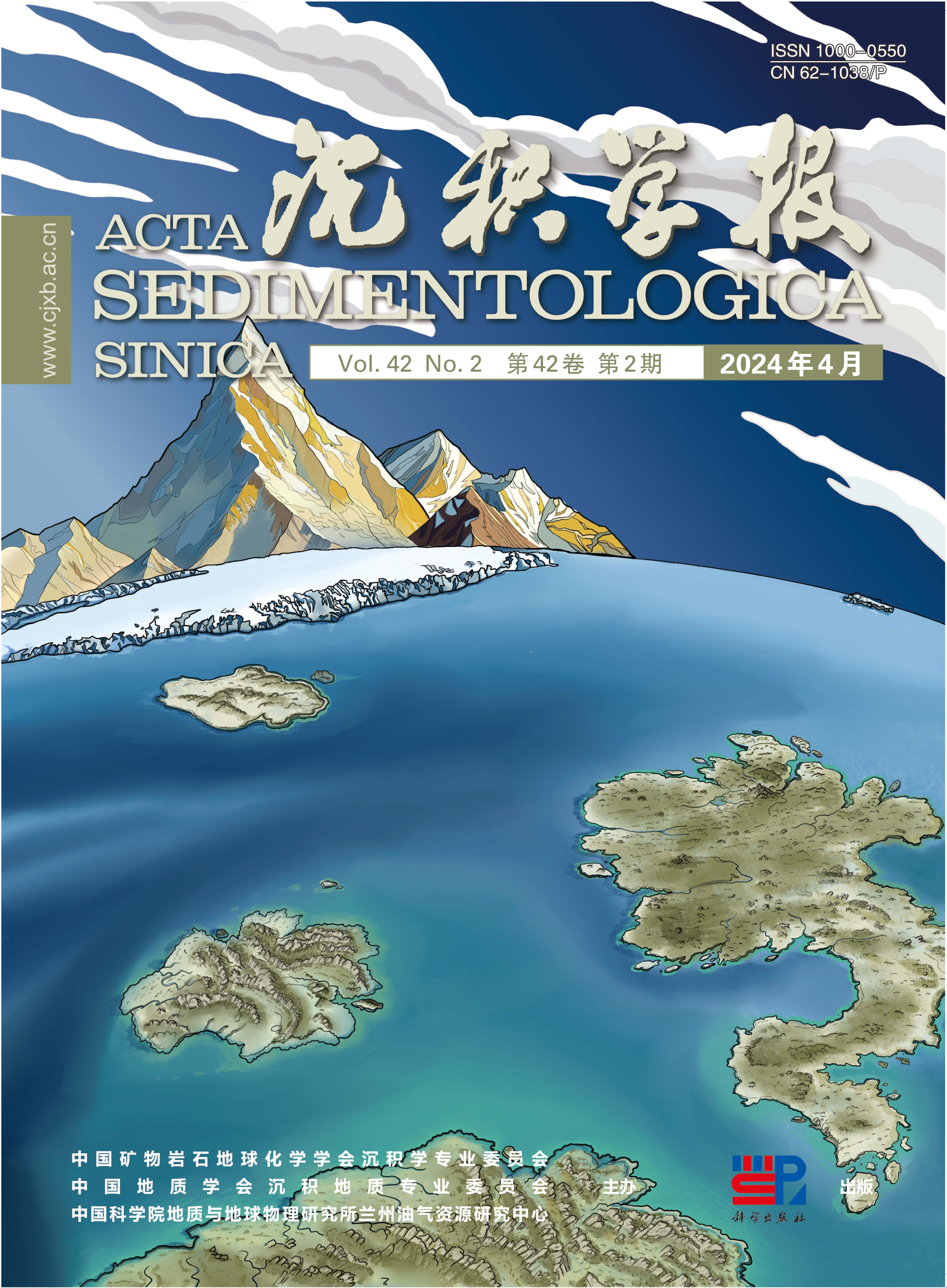









 DownLoad:
DownLoad:
